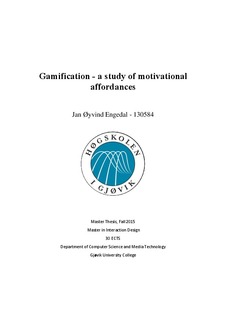Gamification - a study of motivational affordances
Master thesis
Permanent lenke
http://hdl.handle.net/11250/2389262Utgivelsesdato
2016Metadata
Vis full innførselSamlinger
- Institutt for design [1129]
Sammendrag
Gamification is the use of game mechanics and game design elements to increase user motivation and enjoyment in non-game related context. This master thesis investigated the potential differences between the 10 most used motivational affordances, and how they are mapped to different players and learners, characterised by various player types and learning styles. The player categorisation model used in this study is Nick Yee’s model, which is a categorisation of users’ motivation to play games and consists of the 3 categories Achiever, Social and Immersion. The chosen learning style model is the revised Index of Learning Styles designed by Felder and Silverman. The ILS consists of 4 pairs of independent dimensions of learning styles: Active/Reflective, Visual/Verbal, Sensing/Intuiting, and Sequential/Global. The results show that the player categorisation Achiever has a significant correlation to the motivational affordances Leaderboards (P < .00), Levels (P < .00), Achievements/badges (P < .004) and Challenge (P < .003). The player categorisation Social has a significant correlation to Levels (P < .00), Story (P < .001) and Challenge (P < .001). Immersion has a significant correlation to Story (P < .00), Levels (P < .005), Clear goals (P < .004). There were no significant correlations between the motivational affordances and the learning styles, and therefore no correlation between the player categorisations and the learning styles.
